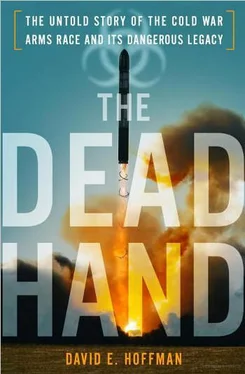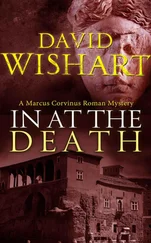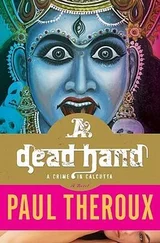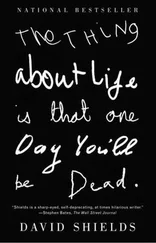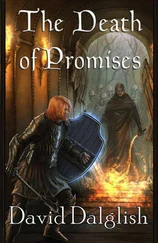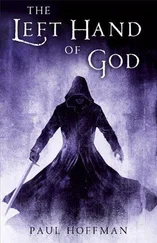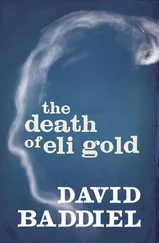The first item on the agenda was listed as “About measures for modernizing the organization of work on special problems.” The term “special problems” was a euphemism for biological weapons. The officials were once again worried about the arrival of international inspectors and how to cover up the illegal work. The goal of the meeting was to prepare a Central Committee resolution, which would be a major policy instruction.
Katayev’s notes of the meeting are fragmentary and leave unanswered questions. But they also open a window on high-level discussions about the illicit germ warfare program—evidence of a remarkable back-and-forth discussion that was kept utterly secret.
Kalinin opened the meeting, suggesting that biological weapons were cheap.
The Katayev notation:
| Per 1 |
conventional |
2,000 doll. |
| - |
Nuclear |
800 ″ |
| - |
Chem |
60 ″ |
| - |
Bio |
1 ″ |
The unit of measurement is not stated, but apparently was dollars. Experts in nonproliferation had worried about the same thing for many years—biological weapons could be the poor man’s atomic bomb.
Then, according to Katayev’s handwritten notes, Kalinin complained that the United States had concealed the location of work on biological weapons.
Next, Kalinin reported to the group on the status of preparations for international arms inspections. Some facilities were being modified so they could be displayed as centers for civilian medicines. According to Katayev’s notes, Kalinin said the cleanup would have to remove any speck of evidence that would point to a weapons program. “Today we are not finding spores,” Katayev wrote. “But possibly in pockets.”
If inspectors came, Kalinin said, they would be given the explanation “these are for manufacturing vaccines.”
Kalinin said he needed eighteen months to bring two more sites into order, and appeared to be seeking permission.
Shevardnadze, who had endorsed the idea of surprise inspections in his speech in Geneva, interjected. “Violation or not?” he demanded, according to Katayev’s notes. “What is the purpose of legends?” or cover stories. “There will be a convention in a year’s time—any enterprise will be under verification.” This was a reference to a chemical weapons treaty, or international convention, which would include provisions for surprise inspections as a verification measure. It was being hammered out by negotiators.
Zaikov asked why Kalinin needed the eighteen months. Couldn’t he be ready sooner?
Kalinin said something about “secret designs,” perhaps hinting that more time was needed to hide the true purpose of the facilities. Katayev noted, cryptically, and without specifying which facilities were being discussed: “All recipes are destroyed. Stockpiles liquidated… Equipment is multi-purpose—remains. It serves to manufacture medications. We are going to preserve the equipment for the time being.”
Zaikov wanted the equipment taken down, too. He was also worried about documents, and wanted them destroyed. At one point he suggested all the documents be “liquidated” in three months. Katayev wrote another cryptic line in his notes, quoting Shevardnadze: “What we violate and what we don’t.”
A little more than two months after the meeting in Zaikov’s office, the Central Committee issued the resolution, ordering more cover-up activity, with an eye toward possible future inspections, according to records in Katayev’s archives. This instruction was to recall all documentation from sites “connected with manufacturing of special-purpose product,” design new means of disguising them and modernize facilities so they could appear to be manufacturing defensive biological agents, such as vaccines. The goal, according to the resolution, was to preserve “the achieved parity in the field of military biology.” 32
A very small group of intelligence officials in the United States and Great Britain worked on biological weapons. They were mainly technical specialists, and they were outnumbered in the intelligence and policy community, where vast staffs worked on nuclear and strategic weapons, and on topics such as the Soviet economy. The CIA even had a full-time analyst devoted to monitoring canned goods in Soviet stores. The germ warfare experts felt like a lonely band, warning of dangers that were often not taken seriously by others and for which they could not offer absolute proof. Christopher Davis, who served on the British Defense Intelligence staff for ten years as the senior specialist on biological weapons, said that methods that had worked for counting nuclear missile silos were virtually useless when it came to assessing a biological weapons program. The missiles and hardware could be tracked from above, but not the pathogens. “A building is a building at the end of the day,” he explained. “It might have some strange features but there is little one can conclude about its function without x-ray eyes. You can’t tell what anyone is doing inside, and that’s the key question. In intelligence terms, it’s a very hard target.” 33
The claims of the biological weapons experts met with deep skepticism by other defense, intelligence and policy officials. “The biological weapons clique inside Washington was so doomsdayish, that they tended to undermine their own credibility,” said Doug MacEachin, who had become arms control director at the CIA in March 1989. “It never had a whole lot of credibility. They went beyond the evidence too many times.” MacEachin was also influenced by his own calculation that biological weapons would have little use on the battlefield; thus no one would go to all the trouble, certainly not in the nuclear age. 34
In the autumn of 1989, Ken Alibek, deputy director of Biopreparat, recalled visiting Obolensk, south of Moscow. On the first floor of the big new building, in the auditorium, the annual review of work at the institute was held. “We were not allowed to bring briefcases or bags inside the room,” Alibek recalled. “We could take notes, but they were gathered up by security guards after each meeting. We had to get special permission to see them again.”
The next-to-last speaker was Sergei Popov, the young researcher who had worked at both Koltsovo and Obolensk. He approached the lectern to give a report on a project that Alibek called “Bonfire.”
“Few paid attention at first. Work on Bonfire had dragged on for some fifteen years, and most of us had given up hope of ever achieving results.”
But Alibek added that his attention perked up when Popov announced that a suitable bacterial host had been found. This was the two-punch weapon in which one agent would be the vehicle and the attack on the immune system would be the second, deadly strike. Alibek recalled watching an experiment involving animals. Alibek wrote in his memoir they were rabbits, but Popov said later they were guinea pigs. Behind glass walls in a laboratory, a half-dozen were strapped to boards to keep them from squirming free. Each was fitted with a masklike mechanical device connected to a ventilation system. Watching from the other side of the glass, a technician pressed a button, delivering small bursts of the genetically altered pathogen to each animal. When the experiment was over, the animals were returned to their cages for examination. They all developed symptoms of one sickness, such as high temperatures. In one test, several also developed signs of another illness. “They twitched and they lay still,” Alibek recalled. “Their hindquarters had been paralyzed—evidence of myelin toxin.”
It was Popov’s two-punch killer agent on display. “The test was a success,” Alibek recalled. “A single genetically engineered agent had produced symptoms of two different diseases, one of which could not be traced.” The room fell silent. “We all recognized the implications of what the scientist had achieved. A new class of weapons had been found.” 35
Читать дальше
